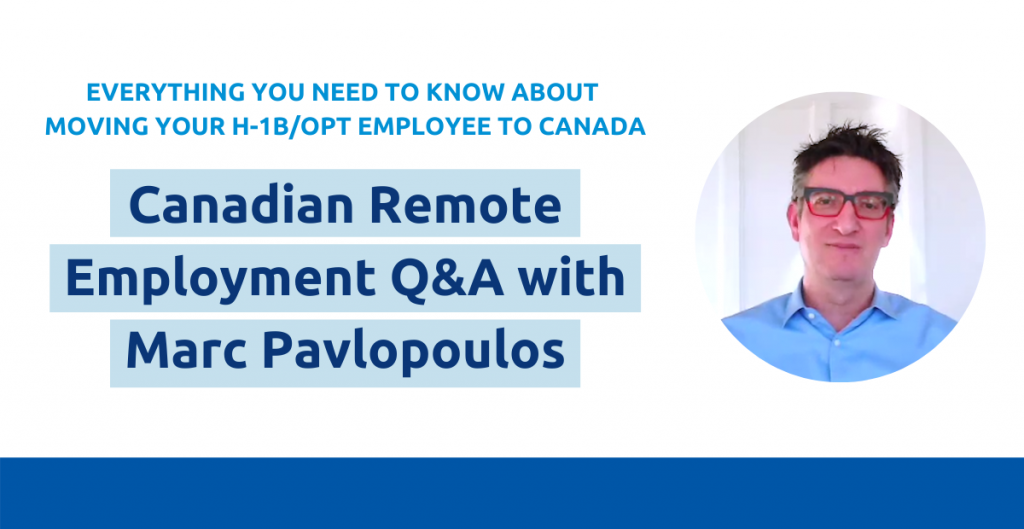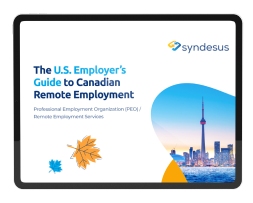The H-1B visa system plays a significant — and complex — role in America’s workforce and the economy as the largest guest worker visa program in the US and it is the primary source of high-skilled labor for many specialized jobs.
But with H-1B cap season upon us, if you’re a tech employer in the US, chances are you’re experiencing those annual H-1B-related anxieties — uncertainty, fear of rejection for your candidates, and a simmering worry that the entire H-1B program is becoming less and less of a priority in the US
Sure, this visa program makes your hair go gray, but oftentimes it feels impossible to ignore.
But rather than stress about H-1B cap season, have you considered looking North?
The H-1B visa isn’t the only option for tech workers in the US — Canada’s Global Talent Stream may, in many cases, enable these same workers to move to Canada, continue to work for you, and finally have certainty about their immigration status from day one.
Here’s what you need to know about the challenges the H-1B visa program faces today and how Canada’s Global Skills Strategy can be a smart alternative.
What is Canada’s Global Talent Stream all about?
The Covid-19 pandemic has slowed — and in some cases even stopped — immigration around the globe, but despite the chaos, Canada’s Global Talent Stream (GTS) program is still working hard to bring talented folks to Canada.
The goal of the GTS program is to expedite and ease the processing time for visa and work permit applications for foreign nationals who possess unique talents or are highly skilled. The typical timelines are 10 business days to assess applications and 14 business days to process work permits for qualified workers, though of course, this was during pre-COVID times.
These speedy processing times are very tempting to many who once had their eyes on H-1Bs in America. Many global high-skilled workers who were once interested in working in the US on an H-1B have turned to Canada because of the long processing times and an increasing rate of H-1B rejections.
The Global Talent Stream was created with the same pool of global talent in mind, and its launch in 2017 could not have come at a better time for the foreign-born high-skilled talent in need of a better option, right after the US federal government started to make things harder for H-1B hopefuls.
GTS empowers Canadian companies to quickly hire highly skilled foreign talent and lets employers skip the Labor Market Impact Assessment process because the skills they seek are in such high demand that the government gives blanket approval to hire those foreign workers.
Overall, GTS has given Canadian employers increased access to global talent, and while overall immigration has slowed, the efficiency and flexibility of the GTS program have allowed Canada to respond to urgent global talent needs during its fight against COVID-19.
The Global Talent Stream and the H-1B program are comparable, but they’re different in some very important ways.
…a PEO can help a small tech startup based in Seattle hire a top-notch artificial intelligence expert in Vancouver. It doesn’t matter if this small startup doesn’t have the resources, or the need, to open up a full-blown office in Vancouver. They can go through a PEO. The PEO then becomes that AI expert’s legal Canadian employer, though they still work for the Seattle-based startup in every other way.
How does Canada’s Global Talent Stream compare to the H-1B visa program for foreign tech workers?
H-1B visas are employer-driven and tied to specific roles, which means that employers petition the government for these visas. Almost 1.8 million H-1B visas have been distributed from 2001 through 2015, and demand for the visa has boomed in recent years. Indeed, the H-1B cap — 65,000 H-1B visas a year plus an additional 20,000 visas for foreigners with a graduate degree from a US university — has been reached within a week of the application period opening almost every year since 2012. And while the H-1B cap process changed in 2020 and is here to stay, H-1B visa demand still far exceeds supply.
About two-thirds of H-1B visa requests are for high-demand jobs in the STEM fields — science, technology, engineering, and math — and these visas are especially vital to the tech industry where H-1B workers hold about 12%–13% of jobs. This may not seem like a lot, but — for comparison — H-1B workers hold about 0.6%–0.7% of American jobs overall.
And since his inauguration, US President Joe Biden has signed a number of immigration-related orders, but have they really impacted the H-1B program at all?
Biden helped protect less-experienced international workers and small- or medium-sized US companies by delaying a controversial wage rule that the Trump administration issued to replace the current H-1B lottery with a wage-based system.
Biden also withdrew a Trump-era plan to end work authorization for certain dependent spouses of H1B holders. This same bill would authorize H-1B holders’ dependents to work, protect H-1B holders’ aging children, and it would eliminate per-country visa caps.
He’s making progress, but Biden could retain some restrictive policies toward foreign workers.
For example, Trump’s rule requiring higher wages for H-1B workers is still set to take effect, and the existing ban on temporary worker visas wasn’t rescinded right off the bat either.
The Biden administration also made no changes to a new H-1B filing requirement that adds layers of complexity and confusion, nor has it moved to change a rule that requires H-1B contract workers to have two companies file an H-1B visa petition for them, even though they will be hired by just one company and contracted out to the other.
Long story short: the H-1B visa remains complex, and while the Biden administration is making progress, H-1B visa holders and hopefuls should have a plan B.
And that plan B should be Canada.
With a PEO, US tech employers can hire their H-1B talent remotely in Canada without having a Canadian office
Rather than wait around for an H-1B in the US, head north to Canada. But how do you — an America-based company — make this happen? The solution is a PEO.
A professional employer organization — commonly referred to as a PEO — gives US-based companies the power to remotely hire someone who is living abroad.
The Canadian PEO represents your company and acts as if you had an official legal presence in Canada. The PEO legally hires your employees, but your US company pays their salary (via the PEO) and manages their day-to-day job.
For example, a PEO can help a small tech startup based in Seattle hire a top-notch artificial intelligence expert in Vancouver. It doesn’t matter if this small startup doesn’t have the resources, or the need, to open up a full-blown office in Vancouver.
They can go through a PEO. The PEO then becomes that AI expert’s legal Canadian employer, though they still work for the Seattle-based startup in every other way.
In addition to hiring, the PEO can handle reporting wages, employment taxes, and payroll. A Canadian PEO can act on behalf of the US employer in employee disputes, workers’ compensation claims, and other legal disputes.
Also, by combining the employees of many companies into one large group represented by the PEO, business owners are offered better rates on healthcare benefits and workers’ compensation coverage.
If working in Canada via the Global Talent Stream sounds a bit easier than the H-1B visa process, that’s because it is.
Let Syndesus help you navigate the Global Talent Stream program
Working in America has long been the goal for many talented tech workers from around the world, but getting an H-1B visa isn’t simple, and keeping an H-1B is just as complicated. Replacing skilled foreign workers who are forced to leave the US is costly and time-consuming.
If you’re employing one of the unlucky H-1B applicants who are at risk, where can you turn? Look across America’s northern border as an option for relocation.
Want to hear more? Book a consultation to chat about your hiring situation. Syndesus can help you expand your team with the world’s most talented technology professionals but without the world’s most frustrating immigration system.





